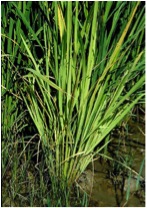Rice yellow dwarf: Candidatus phytoplasma
Symptoms:
- The infected plants are stunted and have yellowish green to whitish green leaves.
- There is excessive tillering and leaves became soft and droop slightly.
- Root growth is also reduced significantly.
- Chlorosis occurs on the leaves occasionally even spreading to the leaf sheaths.
- Streaks may also form parallel to the leaf veins.
- If plants are infected early they usually die before maturity and even if they do survive no panicles are produced or only a small number with no grains.
Mode of spread:
- It is transmitted by Nephotettix virescens and N. nigropictus with a latent period of 25-30 days.
- It survives on several grass weeds.
Management:
- Deep ploughing during summer and burning of stubbles.
- Rice varieties like IR62 and IR64 are resistant to the disease.
- The management practices followed for Rice Tungro Disease(RTD) may be adopted for this disease also.
- Avoiding early planted rice will prevent an increase in vector density and proportion of virus acquired vectors.
- Planting fallow rice fields with non vector hosts, ploughing fallow paddy fields and late-planting,
synchronous planting or avoiding an overlap of early and late planted rice crops.
- Remove weed hosts periodically. .
- Crop rotation .
- The vegetation on the bunds should also be sprayed with the insecticides.
- Chemical Method: Vector control with any one of the following insecticides .
- Thiamethoxam 25 WDG 40g/acre (or) Imidacloprid 17.8 SL 40 ml/acre spray at 15 and 30 days after transplanting .
|
 |

